The ‘Golden State’ of California is not just a great place to live it is a veritable birding paradise. With 4 major regions, consisting of desert, coastal areas, mountain, and the Central Valley you’ve got a great big stewpot of environmental goodness when it comes to hosting a diverse assortment of avian species. Today we’ll talk about the popular backyard birds of Cally and give you some hot tips on where you can go to see them if you have a little time off, barring that you can use our identification and feeding tips in order to lure and perhaps cultivate your own little birding paradise in the backyard. Let’s get started!
3 Categories – 450 Birds
California is home to approximate 450 species of birds so birders here can either be very busy or very slack in their birding and still have a great experience. Today we’ll review a sampling of some of California’s finest feathered friends and we’ll divide them up seasonally like this:
- Year-round Resident birds
- Birds of Spring, Summer, and Early Fall
- Fall and Winter Birds
After you know WHEN to look for them we are going to follow up with where you can spot them as well as what they look like and love to eat. We’ll get started with the year-round resident birds.
California’s Year-round Resident birds
These birds came, saw, and settled. Can you really blame them? California has a number of environments and an excellent climate and these birds have made the decision that they don’t want to be anywhere else. See if you can spot one of these year-round resident birds at any time this year:
- California Scrub-Jay
- California Towhee
- Bushtit
- Mourning Dove
- Black Phoebe
California Scrub-Jay – Aphelocoma californica

Coloration and Markings: California Scrub-jays have backs which are gray towards the shoulders and a rich blue as you go further down. This grey extends into the tops of their long, blue wings and these birds also have long, blue tails with white on gray underneath. These birds have a white underbelly and breast, with blue ‘backpack strap’ marks on the breast, and long, white bibs. The majority of the bird’s face beyond the bib is going to be blue, with large back mask that curves down into the cheek and a thin white eyebrow line. These birds have long, straight black bills with a slight curvature on the upper bill.
Size: These birds measure in at 11 to 11.8 inches in length and have wingspans of approximately 15.3 inches.
Habitat: These birds like open areas, especially Oak stands where they can get a hold of acorns. You can also find them in chaparrals near the coast, as well as the forest’s edge in some areas. These birds are not shy of people and will happily visit your backyard feeder if you leave a little something out for them.
Diet: These birds like suet, crunchy peanut butter, and mealworms but you can also get some mileage with assorted fruits.
California Towhee – Melozone crissalis

Coloration and Markings: California Towhees are almost solidly gray or matte brown, with some important exceptions. They have short wings and long tails and you will notice underneath the tail a rust-colored patch as well as a light peppering of rust on the underbelly. Facially, there will also be rust coloration present in front of the eyes and under the short, stout, and conical silver bill.
Size: These birds measure in at 8.3 -9.8 inches in length and have wingspans of approximately 11.4 inches wide.
Habitat: These birds love dry spots, especially shrubs and chapparal. That said, they also are no strangers to towns and cities so leave out a little something in your backyard if you’d like to get their attentions.
Diet: California Towhees like suet but they will also eat small fruits and berries. Try an assortment of fresh or dried fruits that you have around and put them out with the suet for best results.
Bushtit – Psaltriparus minimus

Coloration and Markings: Bushtits have grayish-blue or plain brown backs as well as short, gray wings and long, gray tails. The breast and underbelly will typically be brown or grayish with some tan coloration mixed in and facially, these birds are mostly brown or gray with one exception. There will be a mask which goes through the eyes and down into the cheeks but it will be faint or slightly darker depending on the region. These birds have tiny, stubby black bills.
Size: These little guys are TINY, measuring in at just 2.8 – 3.1 inches and with wingspans approximately 6 inches from tip to tip!
Habitat: These birds love to be around Evergreens and Oak stands but you can also find them around scrubland and next to ponds or streams. They do venture into the suburbs fairly often so keep an eye on your backyard feeders and leave something thoughtful out to see if they notice.
Diet: Crushed peanuts and suet are a great way to get and keep the attentions of the lovely Bushtit.
Mourning Dove – Zenaida macroura
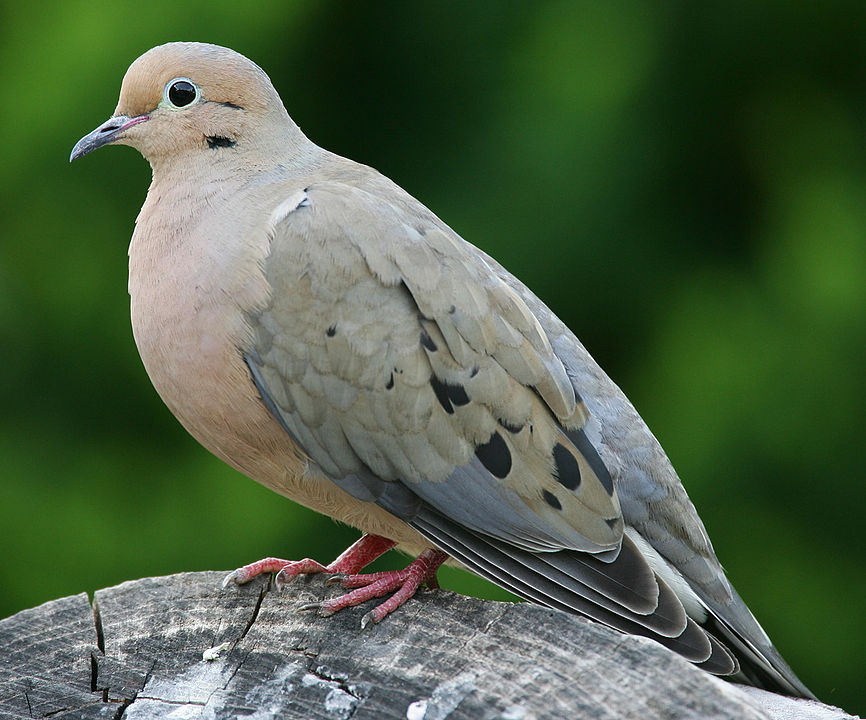
Coloration and Markings: Mourning Doves are plump and pretty. They are commonly light brown or gray, with large, gray wings that have a heavy infusion of tan coloration towards the center to go with their distinct and large black spots. They have long, pointy tails and the breast and underbelly of this bird are a white mixed with a creamy tan hue. Facially this birds has the deepest concentration of buffy-tan color and you will see a thin, white eyering. These birds have medium-length, straight black bills.
Size: These Doves measure in at 9.1 – 13.4 inches from tip to tail and have wingspans approximately 17.7 inches wide.
Habitat: These birds love open areas, be they meadows, fields, or even just some bare sidewalk or ground. They are also quite comfortable in the suburbs and you can see them around town, often perched on phone lines or fences or simply strolling out in the open at your local park.
Diet: Crushed peanuts, White Proso millet, cracked corn, and wheat are all favorites of the Mourning Dove that can potentially lure them in so you can get a closer look.
Black Phoebe – Sayornis nigricans

Coloration and Markings: Black Phoebes are mostly ash gray in color. They have ash-gray backs, medium length wings, and long, ash-gray tails. Their rump and underbelly, however, are snowy-white but this too becomes ash gray as the coloration approaches the breast. Facially, they will be the same gray color and they have thin, medium-length straight black bills with a minute curvature present on the upper bill.
Size: These birds measure 6.3 – 7 inches in length and have wingspans of approximately 11 inches wide.
Habitat: These birds are almost always found next to the water. Look for them near rivers, streams, or around the coast.
Diet: Live mealworms make the best lure but if you don’t have that handy then suet cakes will do in a pinch!
California’s Birds of Spring, Summer, and Early Fall
California poppies tend to arrive around the 4th of March, heralding the arrival of spring and the incoming approach of the summer to follow. The birds in this category may be seen most commonly between spring and early fall. See if you can spot one of these guys or gals next time you are out or sipping some iced tea in your backyard:
- Cliff Swallow
- House Finch
- Northern Mockingbird
- Indigo Bunting
- Blue Grosbeak
Cliff Swallow – Petrochelidon pyrrhonota

Coloration and Markings: Cliff Swallows have backs which are a dark, metallic blue although you can see some pumpkin color towards and at the rump. They have long wings which are dark brown with some metallic blue at the shoulders as well as a line of pumpkin behind the shoulder and they have short, fanning brown tails. Their breast and underbelly are white with some minute rust-colored flanking under the wings and at the apex of the breast. Facially, they have reddish brown heads with some blue at the base of the throat as well as a bicolored cap which is blue in the back and white to pumpkin at the front as well as a brown half-mask in front of the eyes. These birds have short, pointy black or brown bills. A white patch at the throat seen only in the warmer months is often a sign that you have identified a Juvenile Cliff Swallow.
Size: These birds measure in at approximately 5.1 inches from tip to tail and have wingspans of 11 to 11.8 inches in width.
Habitat: As the name suggests, these birds like to nest in the cliffs and rocks but in suburban areas they can often be found near bridges or other areas near water.
Diet: These birds are primarily insectivorous, so try some dried or live mealworms, or berries will work in a pinch as they sometimes supplement their diet with these.
House Finch – Haemorhous mexicanus
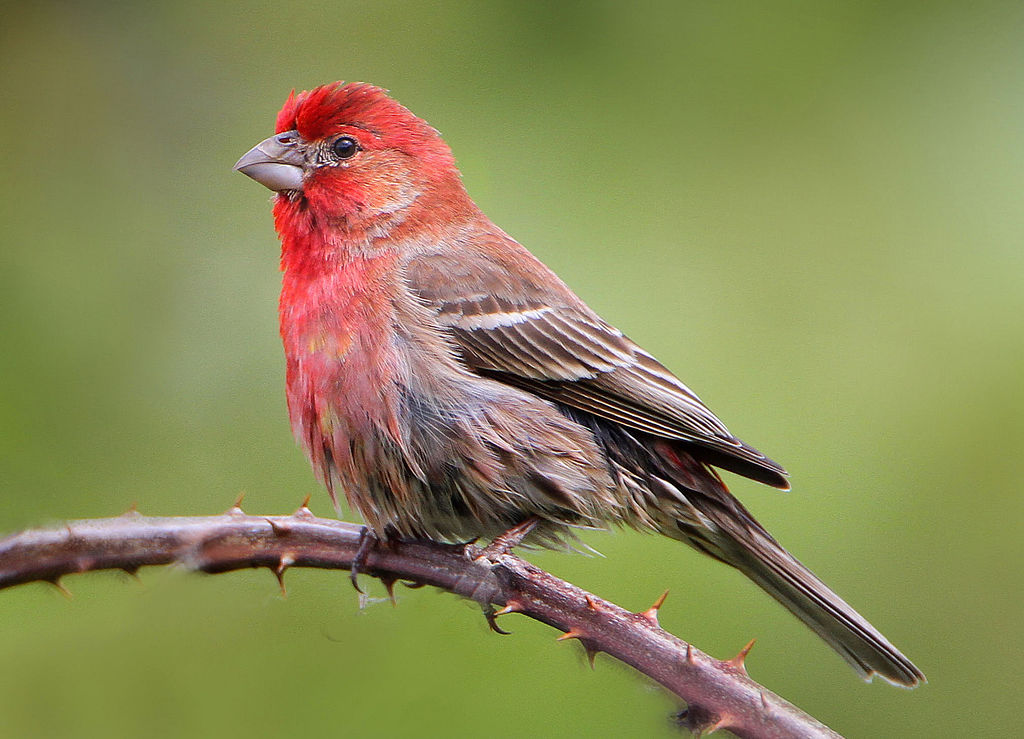
Coloration and Markings: Male House Finches have brown or grayish streaked backs, with short wings which sport 2 wingbars on each and a banding of vertical dark gray or black lines. They have long, notched gray tails with white on the outside and the underbelly is white with brown streaks which changes to white with rosy-red spots in rich concentration as the color moves up the breast. This red continues into the face where it covers the cheeks and the top of the head from the front to the back. A gray or brown eyeline passes through the eye and curves around to frame the cheek while also splitting off towards the lower portion of the neck. Females lack this facial marking and the red color as well, being gray or brown with thicker, somewhat blurred streaking. These birds have short, stout silver bills with a noticeable curve on the upper bill.
Size: These birds measure in at 5.1 – 5.5 inches in length with wingspans of 7.9 to 9.8 inches in width.
Habitat: These birds like open areas and areas with dense vegetation. You can see them around desert scrub, chaparrals, or at the forest’s edge and they are also quite fond of farms and cities.
Diet: White Proso millet, Nyjer thistle, and Black Oil Sunflower seeds are all favorites of the House Finch and might just earn you a visit if you’ve put one or more in the feeder.
Northern Mockingbird – Mimus polyglottos

Coloration and Markings: Northern Mockingbirds have grayish-brown backs as well as long, gray-brown wings which sport 2 wingbars on each wing and a large white patch which is visible when the bird is in flight. They have long, gray tails with white edging and the breast and underbelly of this bird are white, with a little brown sometimes mixed in at the underbelly. Facially, the white from the breast pulls up under the bill and shows a little just above it, while the back and top of the head are grayish-brown. This bird has a gray mustache line and a thin, gray mask that passes the eyes and frames around the cheek. These birds has thin, medium-length black bills with a slight curve to them.
Size: Roughly Robin-sized, these birds measure 8.3 – 10.2 inches in length and have wingspans of 12.2 to 13.8 inches.
Habitat: These birds love fields and the forest’s edge but they are also quite at home in towns and cities, so be sure to leave out a treat or three for the Northern Mockingbird.
Diet: These omnivores will eat a lot of different things but an easy and healthy temptation for them is to simply leave out some sliced apples or oranges.
Indigo Bunting – Passerina cyanea

Coloration and Markings: Male Indigo Buntings are beautiful and easy to identify. They are a rich indigo color all over their bodies (with some gray present if they happen to be molting). These little birds have medium length wings and short tails and facially, you’ll notice a little black in front of the eyes and this bird has a stout, medium-length, conical silver bill. Females will be a light brown or olive color with some blue tinges throughout the plumage, but only hints. They also tend to have very light colored throats. Juvenile males will have large patches of blue as well as brown, getting bluer as they mature.
Size: These little guys measure in at 4.7 – 5.1 inches from head to tail and have wingspans of 7.5 to 8.7 inches.
Habitat: These birds love foraging in brush, bramble, thickets, and thorns, especially at the forest’s edge, so look for them there unless you hear them singing. If they are singing, just look up as they prefer the safety of the high trees branches for this action.
Diet: Stock up on Nyjer thistle and fill that feeder up. It’s easy and Indigo Buntings love it!
Blue Grosbeak – Passerina caerulea
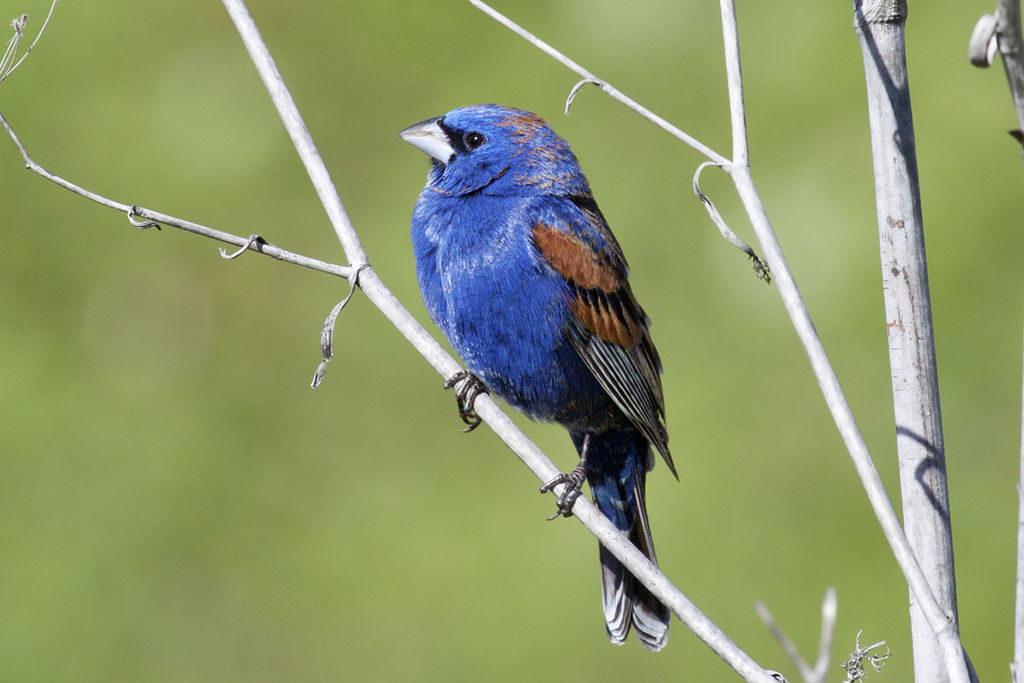
Coloration and Markings: Blue Grosbeaks are almost completely a rich, blue color with a few exceptions. They have long, blue wings with 2 distinct chestnut or pumpkin colored wingbars and the wing feathers towards the center will be tipped with this color as well. They have medium-length blue tails as well as a blue underbelly and breast and facially, the blue gets even richer in color. These birds have large black and silver bills with a noticeable curve to them. Females and juveniles will have different coloration, with females being primarily cinnamon in color rather than blue and the Juvenile males more of a dark chestnut brown color.
Size: These birds measure in at 5.9 – 6.3 inches in length and have wingspans of approximately 11 inches from tip to tip.
Habitat: These birds love fields, especially those at the forest’s edge. Any place with a little dense cover is okay for this bird, however, and they will happily visit a well-stocked backyard feeder.
Diet: While these birds mostly eat insects you can sometimes tempt them with Nyjer thistle, wheat, and oats.
California’s Fall and Winter Birds
With average lows of 40 degrees Fahrenheit, California winters are extremely mild and often the subject of cursing among those who live in much more frigid, freezy states. Though the temperature has dropped it is certainly not enough to fluster the birds in this category. See how many of these winged wonders you can spot this fall or winter:
- Golden-crowned Sparrow
- Lesser Goldfinch
- European Starling
- Fox Sparrow
- Band-tailed Pigeon
Golden-crowned Sparrow – Zonotrichia atricapilla

Coloration and Markings: Golden-crowned Sparrows have brown-streaked backs with short brown, banded wings which display 2 white wingbars each. They have long, brown tails and their beast and underbelly tend to be whitish gray to gray with a flanking of brown under the wings going up to shoulder level. Facially, they have mostly gray faces with a dim gray mustache line and some gray concentration around the cheeks but they also sport a bicolored cap that starts terminates at mid-eye level and is almost completely black except at the forehead, where it is bright yellow. These birds have short, stout, conical silver bills.
Size: These birds measure 5.9 – 7.1 inches in length and have wingspans of approximately 9.74 inches.
Habitat: These birds love the forest’s edge and anywhere that there is some dense cover. Shrubs, chaparral, thickets, and thorns… all of these help this bird to feel safe when foraging, so keep an eye out when the vegetation gets thick and you might just spot the Golden-crowned Sparrow.
Diet: These birds love to eat weed-seeds, so try leaving out some Nyjer thistle aplenty and you might just get their attentions!
Lesser Goldfinch – Spinus psaltria
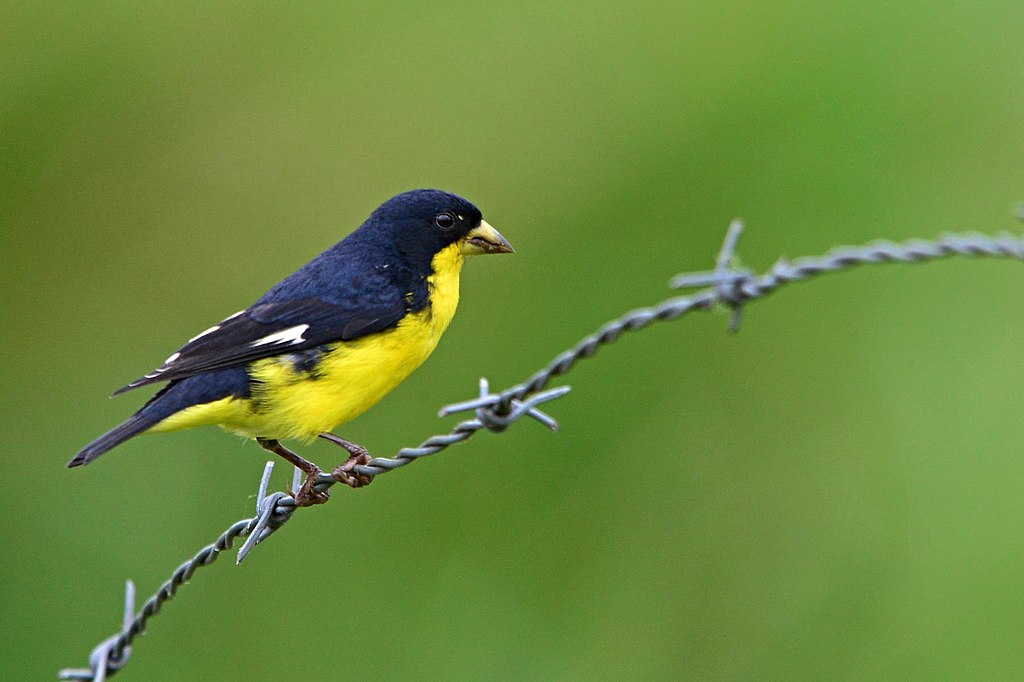
Coloration and Markings: Male Lesser Goldfinches look rather like bright-yellow executioners. They have shiny black backs and long, black wings with a small amount of white patches present. They have short, black tails and the rump, breast, and underbelly are a contrasting bright yellow. This carries up into the face to display just behind the bill and to outline the underside of the cheeks below. The rest of the head is black, giving the bird a ‘hooded’ look, and this look is topped off with a medium length, conical yellow bill. Females and Juveniles will be an olive color, rather than black, with grayish wings which display 2 white wingbars on each wing.
Size: These diminutive beauties measure in at 3.5 – 4.3 inches in length and have wingspans of 5.9 to 7.9 inches wide.
Habitat: Treetops, brush, and even canyons, these birds may be found in a number of places. They are also quite common in the city so keep an eye on your backyard if you have prepared your feeders.
Diet: Black Oil Sunflower seeds and Nyjer thistle will get you a lot of mileage with the the lovely Lesser Goldfinch.
European Starling – Sturnus vulgaris
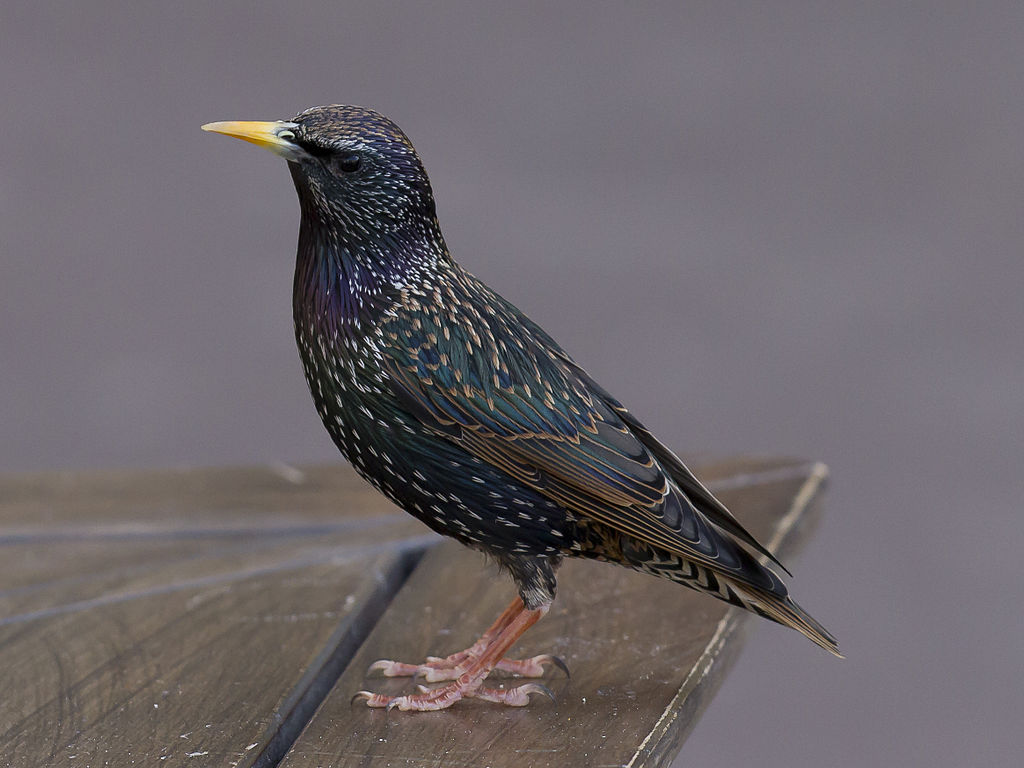
Coloration and Markings: The European Starling looks like a simple Blackbird from a distance, though one with long, straight yellow bill. Up close, however, you can see that this bird is completely covered with a shiny purple-green plumage. They have long wings and tails and in the winter they molt the shiny feathers in exchange for brown plumage with white spots.
Size: These birds measure in at 7.9 – 9.1 inches from head to tail and have wingspans of 12.2 to 15.8 inches.
Habitat: These birds tend to avoid the woods in lieu of farms, towns, and cities. You can see them strolling boldly on the sidewalk or on a fence or phoneline as they check out you and your backyard.
Diet: These birds absolutely LOVE suet and if they eat too much you might want to invest in a ‘Starling-proof’ feeder, leaving them some wheat and oats out by way of placation and apology.
Fox Sparrow – Passerella iliaca
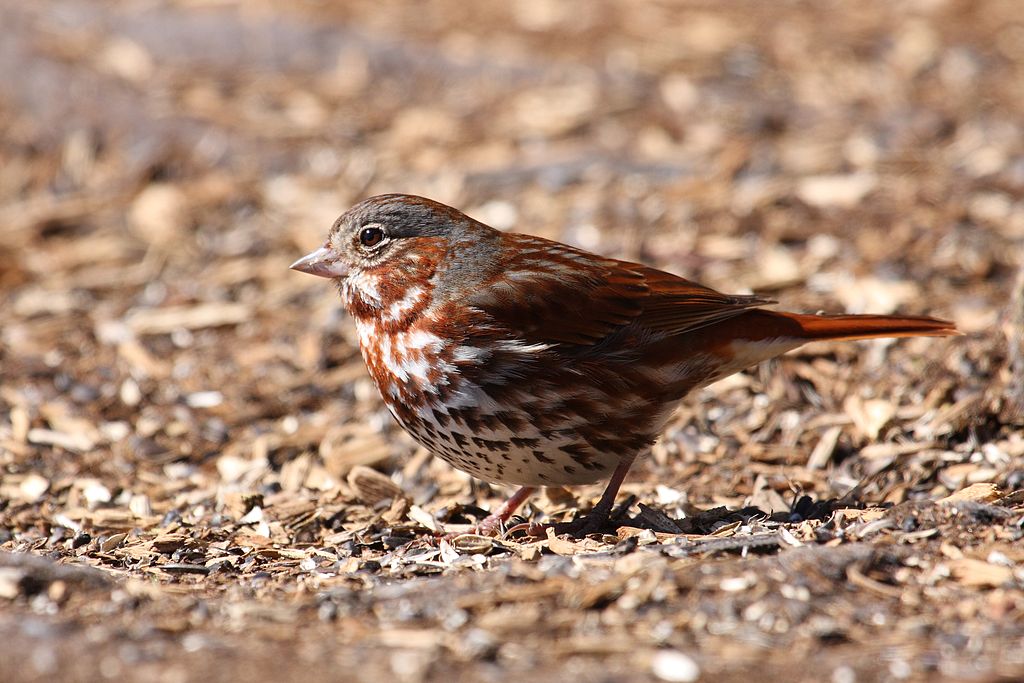
Coloration and Markings: Fox Sparrows have rusty-brown backs, short wings, and long tails, and there is often some foxy-red color towards the wingtips and taking up most of all of the tail except on the undersides, which will be white. The breast and underbelly of this bird typically white with rust-brown or foxy-brown streaks and the face will be a mix of browns and gray which can vary greatly from region to region. These birds have medium-length and conical yellow or dark gray bills.
Size: These birds measure 5.9 – 7.5 inches in length with wingspans of 10.5 to 11.4 inches.
Habitat: Fox Sparrows like coniferous woods as well as mountain scrub, though they do range out *especially in winter) into parks and backyards as they look for their next meals.
Diet: Black Oil Sunflower seeds and fresh Blueberries are a great combination for luring and keeping the attentions of Fox Sparrows.
Band-tailed Pigeon – Patagioenas fasciata

Coloration and Markings: Band Tailed Pigeons are a delicate mix of blue grays and purple grays over most of their bodies. They have long, gray wings and medium-length, rounded tales which are noticeable lighter in color for the bottom half of the tail. These birds have grayish white underbelliy and breast and facially, they tend to be blue and gray and display a white crescent mark at the neck which terminates well below the back of the cheek. These birds have medium-length yellow bills with a very slight curve and which are often black-tipped.
Size: These birds measure in at 13 – 15.8 inches in length and have wingspans of 12.1 to 12.8 inches.
Habitat: These birds love coniferous forests and are fond of Oak stands as well. They range out often, where they may be found in parks, fields, and backyards.
Diet: Band-tailed Pigeons can sometimes be tempted with small fruits and berries. Try grapes and blueberries to tempt there over and experiment a little to keep their interests.
Supporting cast (Other Backyard Birds that might pay you a visit)
Surprise! We’d like to introduce our Supporting Cast birds, who are extra winged celebrities that you can spot at any time of the year, just like those fancy front-page year-round resident birds. These beauties are no less glamorous and with a little patience and some careful feeder planning you might just lure one or more into your backyard. Keep an eye out for these guys:
- Dark-eyed Junco
- Anna’s Hummingbird
- American Robin
- Spotted Towhee
- White-crowned Sparrow
Dark-eyed Junco – Junco hyemalis

Coloration and Markings: While you get a lot of variance from region to region, the most common color configuration of the Dark-eyed Junco when viewed at rest is a bird that is dark brown or gray on the upper 2/3 of the body and white below, like it has been dipped in paint. These birds have dark backs, medium-length wings, and long, gray tails with white undersides. They have a white rump, underbelly, and breast, which have a heavy flanking or dark brown or gray at the sides which is thin at the underbelly but thickens noticeably at the breast. Facially, this bird is dark gray or brown and has a medium-length, conical pink bill.
Size: These birds measure in at 5.5 – 6.3 inches in length and have wingspans of 7.1 to 9.8 inches wide.
Habitat: These birds love coniferous and mixed coniferous woods, where they spend a lot of their time in clearings and meadows. You can also find them in fields, parks, and residential backyards, so be sure to let them know that you are thinking of them with a little love left out in the feeder.
Diet: Cracked corn, White Proso millet, and Black Oil Sunflower seeds work well alone or in combination, but use a ground feeder and scatter some of the seeds below it to help to make sure that they take notice.
Anna’s Hummingbird – Calypte anna

Coloration and Markings: Anna’s Hummingbirds have purplish-gray and emerald green backs, with some yellow coloration just above their medium-length gray wings. They have medium-length tails which are gray tipped and have some yellow and green present and the breast and underbelly of this bird are white and gray, lighting as the color moves up, with a light or heavy flanking of yellow. Facially, these birds have brownish foreheads and there is brown under the bill, reaching towards the cheek, and becoming yellow at the base of the throat. Under the back end of the cheek you will notice a collection of bright pinkish-red coloration and you might see a spot of that on the top of the head and just behind the eye. These is often a small amount of yellow present at the back of the head and these birds have long, thin, and fairly straight black bills.
Size: These little Hummingbirds average 3.9 inches in length from head to tail and have wingspans of approximately 4.7 inches.
Habitat: You can find these birds in a number of places, such as scrub areas by the coast, streamside woods, gardens, and parks. They love backyards as well if you have left out something for them and you should, these are lovely birds that are an absolute delight to have in your backyard.
Diet: These birds like nectar, so the standard sugar water from your Hummingbird feeder will do, but you can leave out dried or live mealworms if you really want to give these birds a treat.
American Robin – Turdus migratorius
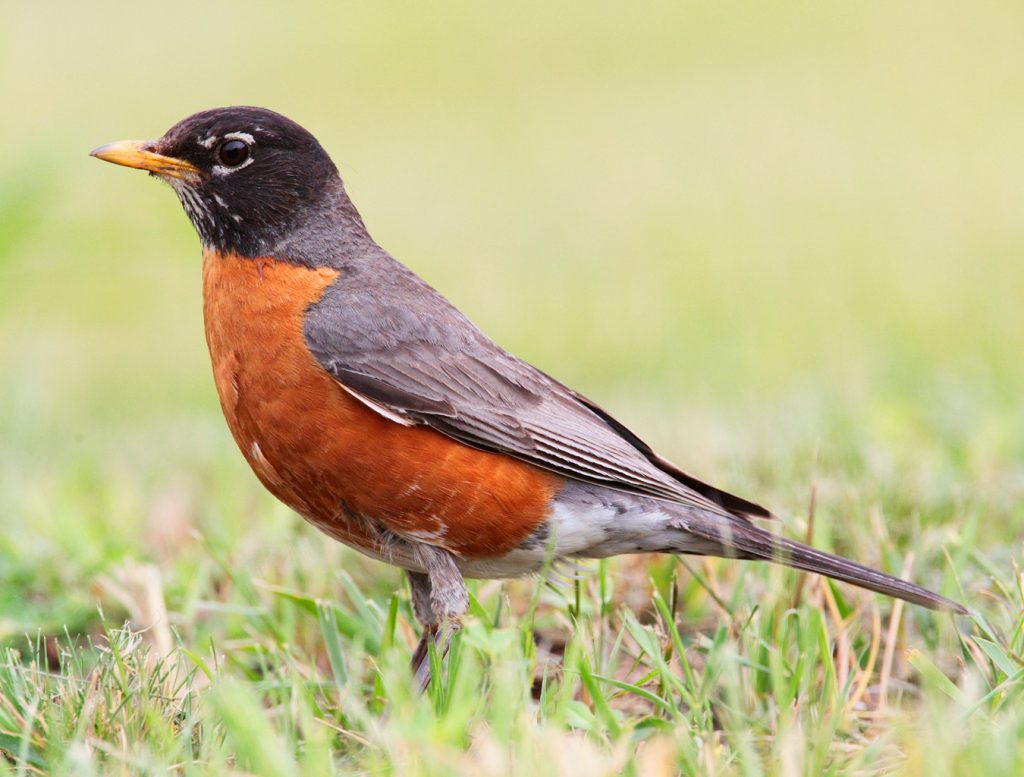
Coloration and Markings: American Robins have lovely coloration, with grayish-brown backs, long grayish-brown wings and long, dark gray tails with white edging at the tips and white on the undersides. The rump of this bird is white as well, while the underbelly and breast of this bird are a lovely apricot orange or orange red color. Robins have black heads with some minute tufts of white just under the bill and a white eyering is present, though it is segmented as if it were dropped and broken. These birds have medium length, slightly curved yellow bills with the occasional black on the tip. Females will have more subdued, paler colors which tend to run together more than the contrasting pattern seen in the males.
Size: These birds measure in at 7.9 – 11 inches in length with wingspans of 12.2 to 15.8 inches.
Habitat: When in the woods, they prefer deciduous areas and are often found near Pines. They range out quite often, however, into parks, golf courses, and backyards as well. These birds are unafraid of the city but often stay close to brush and other dense foliage, so keep an eye out and you might just spot an American Robin.
Diet: Robins will turn their bills up at birdseed but you can really make them happy with some chopped apples and dried or live mealworms.
Spotted Towhee – Pipilo maculatus

Coloration and Markings: Male Spotted Towhees have a black back as well as medium-length black wings which have white spots that look like 2 wingbars on each wing along with a scattering of spots around the shoulder and sometimes a few spots towards the tips of the wings. These birds have long, black tails, with white corners and a red and black rump. The underbelly and breast of this bird are white with a heavy flanking of rufous coloration. These birds have black heads and the black comes down like a bib or beard to triangulate at the top of the breast. You will also notice red eyes and these birds have medium-length, stout, and conical black bills.
Size: Roughly Robin-sized, these birds measure in at 6.7 – 8.3 inches in length and have wingspans of approximately 11 inches in width.
Habitat: These birds like open areas with some dense vegetation where they can forage in relative safety. You can also find them at the forest’s edge, parks, fields, or backyards.
Diet: White Proso millet can get their attention but be sure to use a ground feeder and sprinkle some around the base of the feeder to help to get their attentions.
White-crowned Sparrow – Zonotrichia leucophrys

Coloration and Markings: White-crowned Sparrows are grayish-brown birds that have brown backs with some black spotting and short, streaked brown wings with 2 thin white wingbars present on each wing. They have long grayish-brown tails and their underbelly tends to be white with heavy flanking of light brown on the sides. The whiteand brown become gray as the coloration moves up into the breast and up to the long, thick gray neck. Facially, this bird is gray on the lower portion of the face and up until the bird’s thin, black mask, which goes to the back of the bird’s head. Above this is a heavy eyebrow stripe with a black stripe above it and a white stripe down the center of the head. The effect is much like looking at Skunk stripes. These birds have small but stout yellow or pink bills of conical shape. Juveniles will have brown instead of black on their faces.
Size: These birds measure in at 5.9 – 6.3 inches in length and have wingspans of 8.3 to 9.4 inches.
Habitat: High grasses, weeds, and brush are the combination that attracts this bird. Look for them in fields or at the forest’s edge if you are out and about hiking but just about anywhere with this foliage combination is a potential White-crowned Sparrow spotting in the making.
Diet: Black Oil Sunflower seeds can get this bird’s attention, however, you should use a ground feeder and sprinkle some around the base of the feeder as well, as these birds do prefer to ground-forage.
California Bird Buffet
When you are preparing your feeders there are some basics which you will want to include. You want to have suet, Black Oil Sunflower seeds, White Proso millet, and your secret weapon.. grape jelly. This will turn the heads of many a fruit-loving bird and they just can’t get enough (use that sparingly though because of the sugar content!). There are also some plants that you can cultivate that can definitely get some attention and we thank the Las Pilitas Nursery for sharing some of their tips. You can read their full article in our reference links but here is a taste of some recommended plants to grow in order to make an Avian garden paradise:
- Catclaw
- Chamise
- Western Serviceberry
- Pacific Madrone
California Birding Hot Spots
If you want to take photos or simply get a glimpse of California’s celebrities (of the winged persuasion, of course) then we recommend that you check out one of these hotspots. We’ve got a sampling from various compass points and Central California and you can use our reference link is none of these prove to be close enough. Try to visit one of the following but be sure to bring your binoculars, you don’t want to miss seeing these little wonders in their element. Here are our recommended hotspots:
- Northern hotspot – Clover Creek Preserve Trail
- Eastern hotspot – Sugar Pinbe Trail
- Southern hotspot – Turtle Rock Trail
- Western hotspot – Watsonville Slough Trail
- Central hotspot – Lewis S. Eaton Trail
Detailed descriptions of each location as well as information regarding visiting and what birds you can see at these locations may be found at https://www.traillink.com/stateactivity/ca-birding-trails/
Some Final Words
Today we’ve taken time to give you the briefest glimpse of the birding possibilities in the Golden state. With over 450 birds, this can hardly do it justice, but we hope that it gives you a few ideas and a good starting point. Until next time, we want to wish you the very best in your birding endeavors. Stay patient and keep an eye out, because you’ve got a lot of beautiful California birds just waiting for you to spot them! Happy birding!
